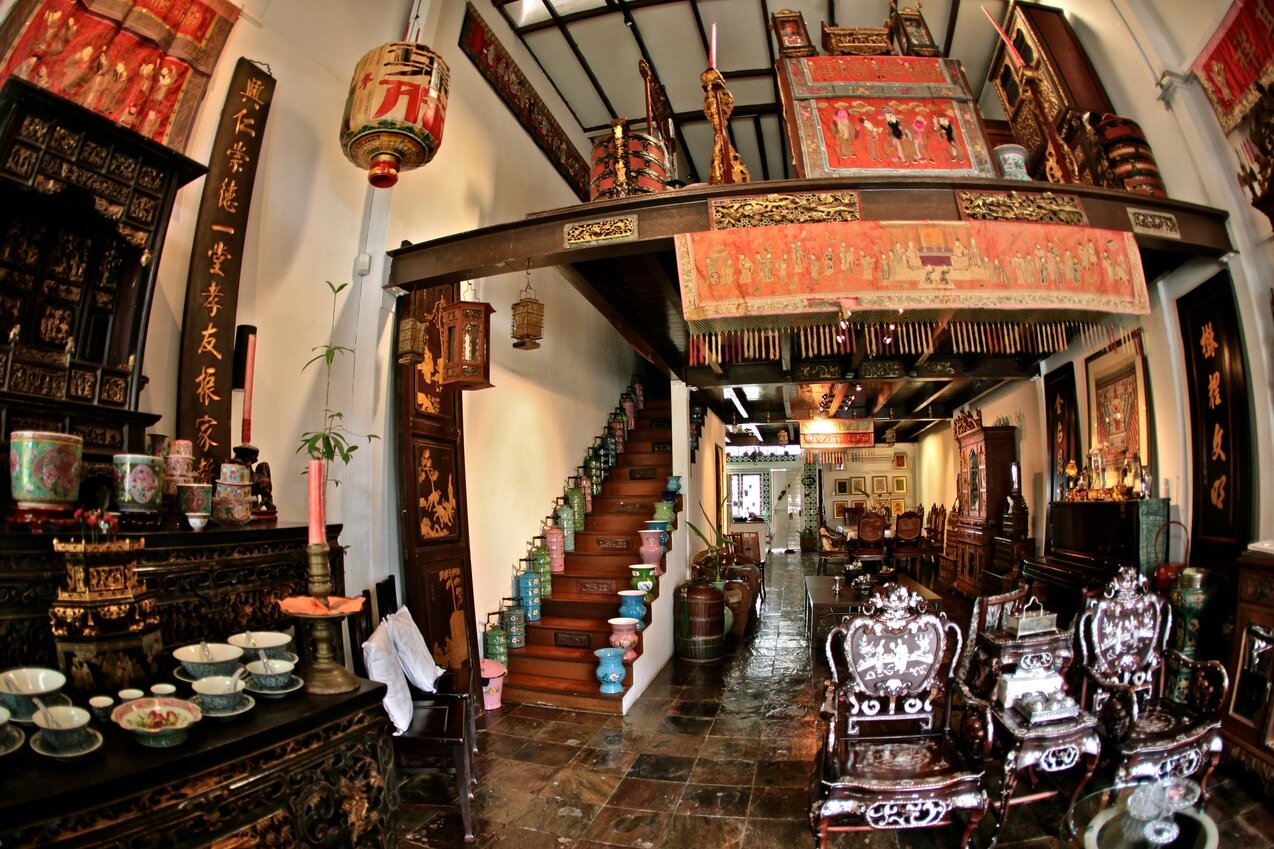Alvin Yapp: A Deep Love For All Things Peranakan
“Hello! Welcome to my home.” You know you’re in for a good time at The Intan museum when Alvin Yapp warmly greets you by the door with his disarming smile. He got me at hello (just like Renée Zellweger in the Jerry Maguire movie).
The resident cum museum owner and curator lives on the second floor of The Intan. This designated Heritage Home is draped in floor-to-ceiling vintage Peranakan artefacts that are all part of Alvin’s personal collection since he was a teenager.
The Intan (Malay for rose-cut diamond) is a treasure chest containing more than 5,000 eclectic objets d’art he has collected for over 30 years.
“With a deep love for all things Peranakan, I have devoted my home to be a haven for the treasures of the Peranakan culture. And it is this love that gives me inspiration to share with you a glimpse of the yesteryear as a guest to my home,” says the avid collector, who turned his residence into a homey private museum in 2003.
Tucked in a nondescript two-storey terrace house in Joo Chiat district, it is easy to miss The Intan. But once you find it, it will be worth the trip. It’s like walking into a historical period docu-drama set. You’ll be engulfed in nostalgia – every piece on display beckons you to hear its story.
His yearning to understand his Peranakan heritage was kindled after watching a play with his parents. He was in his mid-teens when he started probing his ancestors’ culture. His quest to understand his cultural background led him to an inspiring self-discovery journey, and in the process he accumulated priceless Peranakan gems that now fill his house with the good vibes of a bygone era.
“I started collecting little things that embodied the spirit of the Peranakan culture and it just grew,” says Alvin, now in his 50s. “They’re my priceless treasures because with every piece I acquired I learned something new about my culture.”
He was only 15 when Alvin acquired his first Peranakan piece, a planter’s chair that he spotted at a garage sale with his father. He instinctively knew that collecting antiques was one of the best ways to learn about his culture. He reveled in the stories dealers shared with him, and some even welcomed him into their homes, telling tales about the culture, religion, practices and history of their community. It was like bedtime stories moments for him.
The Intan is decked with his collection of intricate wood furniture, kamcheng (covered jars usually used to serve food), Tiffin carriers, kasut manek (beaded slippers), Peranakan Chinese porcelain, Nyonya sarong batik and jewellery, decor knick-knacks (among others). Without a doubt, the ambience will transport you back to an almost forgotten time when descendants of early immigrants in what is now Malaysia, Indonesia and Singapore mixed various influences into something uniquely their own.
Alvin’s fascination with Peranakan culture when he was growing up was more than the fine needlework or craftsmanship that captivated him. Rather, it was the astonishment and admiration at how an immigrant culture, so young and recent, was able to achieve and create a community that influenced every aspect of social life. It was this remarkable conception that inspired primary professions to design and create beautiful works of art. Pottery makers, tailors, cobblers, chefs, jewelers and carpenters were instantaneously turned into artists, drawing inspiration and combining techniques from different cultures. They experimented with different mediums and explored different styles that manifested into forms and expressions never seen before.
“It’s not The Intan’s vision to convert people to Peranakan,” says Alvin thoughtfully. His intention is to inspire an emotional connection with the culture. “We want to make our heritage relevant, and to show the public that we can live with the past in modern Singapore.”
Eighteen years ago The Intan started with zero funding and no paid staff. But it was powered by the passion of volunteers to contribute something meaningful to the community and, in essence, help in preserving Peranakan traditions.
“My biggest volunteers were my parents. They helped me clean the house (The Intan),” he says, reminiscing the early days when he mustered the courage to run The Intan with his parents.
Alvin hosts museum guests that include a walk-through in his home as he shares insights into his culture’s intricacies. What makes the experience even more engaging is Alvin’s ability to weave in a few charming personal narratives. (Given the Covid-19 pandemic restrictions nowadays, you have to pre-book for a personal guided tour with him to fully enjoy his company and the experience).
Before the pandemic, The Intan was buzzing with activities and visitors who heard about it through word of mouth, social platforms and news media.
The Intan, a member of the Museum Roundtable Singapore by the National Heritage board (NHB), also hosted private and corporate functions, art sales and small concerts – some of which were fund-raising efforts for various charities. Using the Peranakan platform, it raised funds for as well as donated art pieces to the NHB.
“We’ve had movie stars, ambassadors, foreign media, and even schoolchildren with scholarships from China came here,” cheerfully recalls Alvin, who is an alumnus of National University of Singapore. “Young Peranakans and people in wheelchairs came to visit... asking me where did this culture come from.”
Visitors to The Intan may have dwindled due to the pandemic, but it didn’t stop Alvin from keeping the Peranakan spirit alive. In the past year or so, The Intan had initiated collaborative projects with both the government and private sectors. Among them are the weekly virtual tours for 20-100 signed-up participants, working with F&B partner Tung Lok restaurant chain to deliver Peranakan savoury dishes and premium Peranakan cuisine bentos prepared for special events, and its inclusion in Singaporediscovers campaign to stimulate tourism.
It launched The Intan Atelier in collaboration with Raffles Hotel carrying a range of merchandise under The Intan Cares initiative that brings marginalised communities together to enable social impact and enrich local communities. By creating Peranakan-inspired gifts, The Intan Cares enables them to be a giver rather than a beneficiary, distracting them from their illness, relieving stress and helping them earn passive income.
All products by The Intan Cares are crafted or packed by individuals wishing to find employment but are unable to do so due to physical constraints or caregiving duties. The gifts and keepsakes purchased make a difference to those struggling to overcome the obstacles they face. These include people fighting their battles in autism, disabilities, cancer, mental illness, motherhood and seniors who are at risk of isolation.
In late 2020 The Intan unveiled T-Play Khatib, Singapore’s first and only Peranakan-themed children’s indoor playground, in partnership with HomeTeamNS. The 650-square-metre fun and learning wonderland is open to kids ages 12 years and below.
Despite its struggles nowadays, Alvin feels positive about fulfilling The Intan’s mission.
“It’s an interesting time to learn about culture. We are at the forefront of Peranakan culture especially for those searching for their heritage identity,” he declares.
The flames of his collect-and-preserve passion is fanning his burning purpose: sharing knowledge and often-untold stories about the rich Peranakan culture, people, history and lifestyle that go back to the 16th century.
“It’s wonderful to share something with people. It makes me happy to see a person smiling when he leaves The Intan,” says Alvin, who once worked for Singapore Airlines as a station manager and other middle-management positions for nine years including overseas postings in San Francisco and Dhaka (Bangladesh).
As if managing The Intan museum is not enough work, Alvin is simultaneously overseeing the day-to-day business affairs of BusAds, a family-run printing enterprise that specialises in large-print formats and outdoor advertising founded by his father over 30 years ago.
“Welcome to my home. Welcome to The Intan, and experience the flight of the Phoenix and the beauty of the Peony,” says a perky Alvin as he leisurely showed me around the first time I visited his museum. Regaling me with his personal anecdotes (too many to mention) as well as historical accounts of everything Peranakan, it was one of the most memorable, most animated interviews I’ve ever had. This proud Peranakan descendant is a storyteller extraordinaire.
Debbie | ws
(Images: The Intan)
Customised visits: The Intan is a heritage space that can accommodate up to 40 guests to host weddings, private photo-shoots, corporate meetings, celebration events, anniversaries. Prevailing Covid-19 safety measures are strictly implemented.
Open to the public. | Visits are strictly by appointment only. | Book A Visit | Guided Tour Options | Location: 69 Joo Chiat Terrace, Singapore 427231 | Phone: +65 6440 1148













